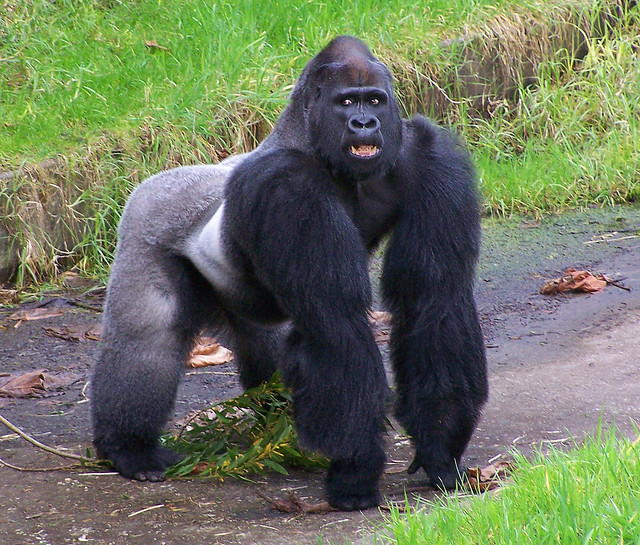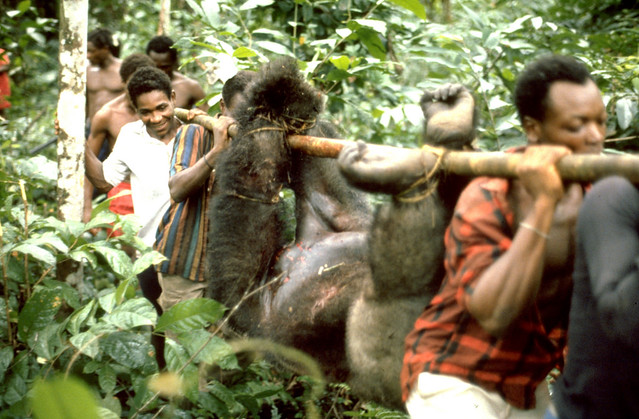根據最新版的IUCN紅色名錄,人類非法狩獵東部低地大猩猩取其獸肉,使其數量從1994年的1萬6900減少至2015年的3800隻,下降至少77%,保護等級上升至極度瀕危。
大猩猩物種如今全部瀕危。圖片來源:James Gaither(CC BY-NC-ND 2.0)。
二物種四亞種 大猩猩全部瀕危
9月1日是世界自然保育聯盟(International Union for the Conservation of Nature)世界保育大會開幕式。三年一次的世界保育大會首次在美國舉辦,來自全球192國的代表齊聚檀香山參加大會。
大會上發表的報告指出,許多大猩猩物種存續狀況非常危急。
大猩猩有東部大猩猩和西部大猩猩兩個物種,兩個物種各有兩個亞種。東部大猩猩包括東部低地大猩猩(Gorilla beringei graueri)和山地大猩猩(Gorilla beringei beringei);西部大猩猩包括西部低地大猩猩(Gorilla gorilla gorilla)和克羅斯河大猩猩(Gorilla gorilla diehli)。兩個物種四個亞種現在在紅色名錄上都是極度瀕危。
本次保護等級修改以今年稍早野生物保育協會(Wildlife Conservation Society,WCS)和國際野生動植物保護組織(Fauna and Flora International,FFI)的調查結果為基礎。調查結果顯示,東部低地大猩猩數量減少的主因是非法狩獵和棲地政治動盪。
此次紅色名錄修改的主要作者Andrew Plumptre警告,圈養的東部大猩猩數量很少,一旦野外滅絕就會永遠滅絕。
WCS和FFI用三種統計方式得到過去20年間東部低地大猩猩數量下降77%的結果。其他統計方法甚至指出,部分地區數量下降高達94%。
極度瀕危的認定標準是三個世代之內數量下降80%。由於大猩猩比較長壽,20年是一個世代的壽命。
地處偏僻 礦區非法狩獵取獸肉果腹
調查東部低地大猩猩數量的科學家說,數量減少的主因是人類非法狩獵以取得獸肉,尤其是剛果民主共和國東部森林中武裝集團建立的村莊和採礦營地。
採礦者和武裝份子因地處偏僻,往往獵取大猩猩的獸肉果腹。攝影:Edmond Dounias。圖片來源:CIFOR(CC BY-NC-ND 2.0)。
這些採礦營地的所得用來取得武器以持續武裝活動,由於地處偏遠,難以偵防。由於遠離人群和道路,往往也是大猩猩僅存的地方。
這些地區沒有農業,所以採礦者和武裝份子只能獵捕獸肉果腹。大猩猩在平地移動而且集體生活,容易追蹤,每個彈匣所能取得的獸肉也較多,自然成為目標。
WCS DRC專案主任Deo Kujirakwinja在大部分東部低地大猩猩出沒範圍都建立了資料搜集機制。「調查報告的數據來源,是DRC保護區管理當局ICCN的巡守員以及當地社群在SMART(Spatial Monitoring And Reporting Tool)空間監控和回報工具軟體中輸入的資料。這種監控資料庫非常有價值,必須要獲得支持以持續監控。」Kujirakwinja說。
過去15年間,只有卡胡茲—別加國家公園中的高地地區大猩猩數量增加,也只有這裡投入了資源,保護大猩猩免於被狩獵的命運。
上述結果也同步發表於《PLoS One》期刊。
“Our planet is most certainly at a crossroads,” declared Zhang Xinsheng, president of the International Union for the Conservation of Nature, Thursday at the opening ceremony of the IUCN World Conservation Congress.
“This unique gathering of top minds holds the key to innovation, inspiration and most importantly, action,” he told delegates from 192 countries gathered in Honolulu for the triennial event, the first ever held in the United States.
A report released at the conference today indicates that many of the world’s gorillas may not be here tomorrow.
The Eastern lowland gorilla, called Grauer’s gorilla, Gorilla beringei graueri, is newly listed as Critically Endangered due to illegal hunting for bushmeat, according to the latest update of the IUCN Red List of Threatened Species.
Hunting has made the Grauer’s gorilla population plummet by 77 percent since 1994, falling from 16,900 individuals to just 3,800 in 2015.
Gorillas are divided into two species – Eastern and Western – each with two subspecies. The Eastern gorillas include the subspecies Eastern lowland gorilla, Gorilla beringei graueri, and Mountain gorilla, Gorilla beringei beringei.
The Western gorillas include the subspecies Western lowland gorilla, Gorilla gorilla gorilla, and the Cross River gorilla, Gorilla gorilla diehli.
Both species and all four subspecies are now listed as Critically Endangered on the IUCN’s Red List of Threatened Species.
The new designation for the world’s largest living primate follows a report earlier this year by the Wildlife Conservation Society, WCS, and Fauna & Flora International, FFI, showing the collapse of Grauer’s gorilla numbers due to illegal hunting and civil unrest.
Few Grauer’s gorillas exist in captivity and if this ape becomes extinct in the wild it will be lost forever, warns Andrew Plumptre, lead author of the revised listing.
The WCS and FFI surveys documented that Grauer’s gorilla has declined by at least 77 percent over the past 20 years using three methods of estimation. Other methods estimated up to a 94 percent decline at specific sites where they have been monitored over time.
A decline of 80 percent over the time span of three generations leads to a listing of Critically Endangered status. Twenty years is considered to be the duration of one generation for these gorillas, as they are a long-lived ape.
The scientists who surveyed the Grauer’s gorilla population say the main cause of the decline is hunting for bushmeat, which is taking place around villages and mining camps established by armed groups deep in the forests in eastern DR Congo.
The mines are set up in remote areas to provide the financing for weapons to continue the armed struggle by these groups. Being deep in the forest to avoid detection, they are also in the areas where gorillas have tended to survive because of the remoteness and distance from villages and roads.
There is no agriculture in these sites, so the miners/rebels can only subsist off bushmeat. Gorillas provide more meat than most species per shotgun cartridge and can be tracked easily because they are mainly terrestrial and move in a group, making them vulnerable to hunting.
WCS DRC Project Director Deo Kujirakwinja, who has established the data collection across most of Grauer’s range, said, “The data used to estimate this decline came from park rangers of the DR Congo protected area authority ICCN as well as local communities which are entered in software called SMART (Spatial Monitoring And Reporting Tool). It shows the value of such monitoring databases once established and it is vital they continue to be supported to allow us to continue to monitor the gorillas in future.”
Only one site, the highland sector of Kahuzi-Biega National Park, has shown an increase in gorilla numbers over the past 15 years and only where resources have been invested to protect these apes from hunting.
These results have just been accepted for publication in “PLoS One,” an open source and peer reviewed scientific journal.
※ 全文及圖片詳見:ENS


